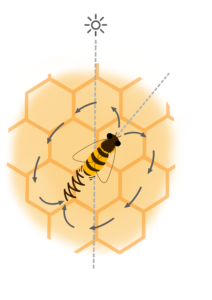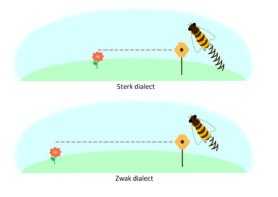To Bee or not to Bee?
Wag that butt: Bee body language
Written by: Jolijn Jansen
After a boring corona winter, we are ready to party. But we humans are not the only ones with an urge to dance. The insects in our garden are also coming back to life now that the sun is out. A real party animal is the bee. They dance to their heart’s content! Bees use dance steps to let each other know where the best treats can be found.
Their dance is called the waggle dance and can be compared to our language. Recent research from the National Center of Biological Sciences in Bangalore, India, looked at dialects in this bee language. They found that some bee populations dance longer than other populations to indicate a treat at an equal distance from the hive. But how can you communicate through dancing in a dark beehive? And how did those dialects develop?
Waggle dance
Contrary to our elaborate language, bees can only communicate the direction, distance and attractiveness of a food source, water source or nesting location with their dance. To do so, they use an 8-shaped dance routine that consists of two phases (Figure 1). The first is the waggle phase, in which the bee walks forward while shaking its butt. This phase is followed by the return phase back to the starting position.

Figure 1. Waggle dance (Jolijn Jansen, 2021)
The waggle phase is the most important because it contains information about the location of the source. First, the dancing bee indicates the direction of the source by moving in an angle from an imaginary vertical line. This angle is equal to the angle between the source and the sun. Then the bee indicates the distance to the source by varying the duration of the waggle phase. The further away the source, the longer the waggle phase will last. Finally, the degree of butt shaking indicates how attractive the source is. Bees that shake harder with their butt will therefore attract more bees to their location. (Want to try? Play the bee dance game!)
Since some honey bee species live in a cavity or beehive, their bee dance takes place in the dark. We asked Dr. Ebi George of the National Center for Biological Sciences to explain how bees communicate without seeing: “Follower bees position themselves on the sides of the dancing bee. Here they can probably feel with their antenna what the dancing bee is doing. If so, the number of antennal touches could, for example, indicate how long the waggle phase lasts.” Assistant professor Marie José Duchateau of Utrecht University adds: “Some species also feel the vibrations in the bee nest and all bees hear the buzzing sound.” Just like humans, bees use their entire body to communicate.
One language, multiple dialects
If you take a look into the hive of different honey bee species, you will soon notice that all species perform roughly the same pattern to communicate; so you could say they speak the same language. However, just like humans pronounce words differently, bees also differ in their dance slightly from population to population. This is called a dialect. Dr. Ebi George lists a few of these differences: “Some honey bee species not only move from left to right during the waggle phase, but also up and down or they produce extra sounds during the dance.”
This year, researchers at the National Center for Biological Sciences in India discovered another difference in the duration of the dance. In their study, they compared the duration of the waggle phase with the distance to artificial food sources of three honey bee species (Apis cerana, Apis florea, Apis dorsata). Bees snacking off the food dishes were marked with a small paint stain. This way, the dance of these bees could be followed when they returned to the beehive.

Figure 2. Bee dialects (Jolijn Jansen, 2021)
Different populations were found to have different durations of the waggle phase to indicate food sources with the same distance from the hive. Scientists distinguish between strong dialects and weak dialects. In bee populations with a strong dialect the duration of the waggle phase increases rapidly with small differences in distance, whereas in populations with a weak dialect the duration increases much less with distance.
Food distance determines dialect
It is striking that the strength of the dialect does not depend on the species but on the average distance between the hive and a food source. This was discovered when Ebi George and his team compared research from bees in a temperate climate, such as the Netherlands, to the same honey bee species in their tropical climate. In general, more food can be found close to the hive in tropical than in temperate climates because the temperature and humidity are optimal for flowering. As expected, the comparison showed that in temperate climates, bees have to fly farther to find food and therefore have a weaker dialect than the same species in tropical climates, where food is closer.
This difference in average food distance partially explains why bees have dialects. According to researchers at Michigan State University, the waggle dance has a maximum duration. Too long dances would be time inefficient or cause translation errors. Hence populations should adapt their dialect to the average food distance to indicate locations as accurate as possible. This is called the adaptive-tuning hypothesis.
Honey bee dialects are an important scientific topic. Assistant professor Marie José Duchateau explains why: “Long ago our Dutch black honey bee (Apis mellifera mellifera) was crossed with the Italian red honey bee (Apis mellifera ligustica). These honey bee breeds seem to dance in a different dialect causing miscommunication within populations.” Research into these dialects thus tells us more about which honey bee breeds can be successfully crossed. It can also show which species are best suited for our climate conditions and how we give bees the best chance to survive in our rapidly changing climate.
In summary, bees communicate through an 8-shaped dance routine, which other bees can feel instead of see. The performance of the dance differs slightly per dialect, just like our language. These dialects were developed because bees want to explain as precisely as possible where the best treats can be found within their food area.
Would you like to watch the bee dance in your own backyard? Place an insect hotel. This is not only fun for you, but also increases the chances of bee survival in the Netherlands!
Translated from Dutch

Figuren vallen onder een Creative Commons Naamsvermelding-NietCommercieel-GelijkDelen 4.0 Internationaal-licentie.

